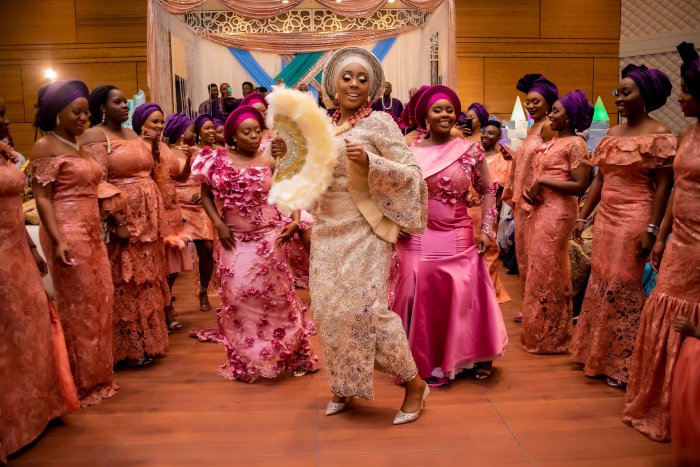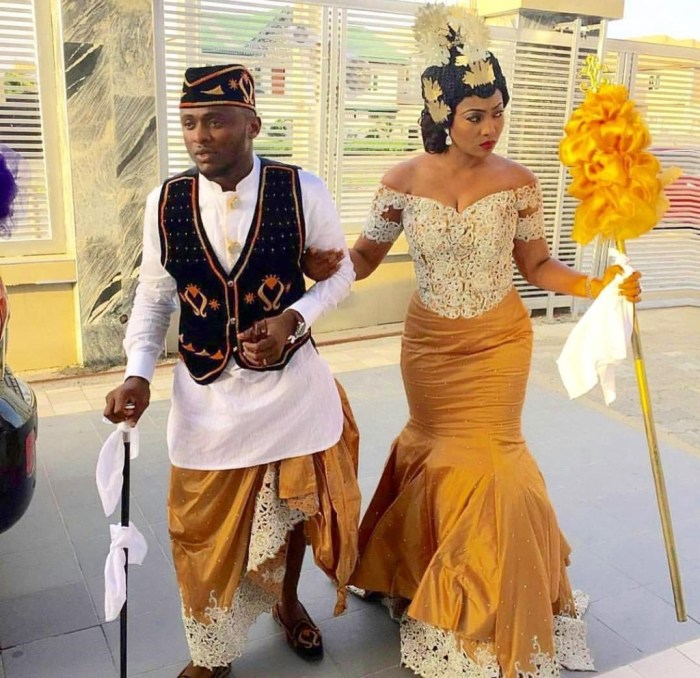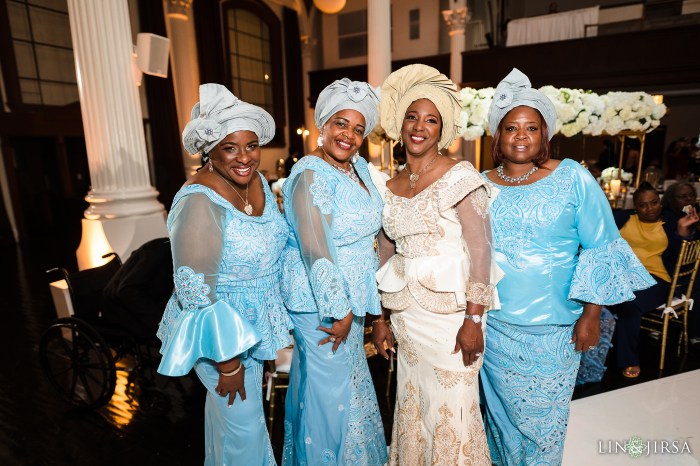Traditional Nigerian Wedding Dress A Cultural Tapestry
A Journey Through Time: The Evolution of the Nigerian Wedding Dress: Traditional Nigerian Wedding Dress
Traditional nigerian wedding dress – Nigerian wedding attire boasts a rich tapestry woven from diverse cultural threads. This exploration delves into the historical evolution, regional variations, symbolism, and modern interpretations of these stunning garments, showcasing the enduring beauty and cultural significance embedded within each design.
Historical Evolution of Nigerian Wedding Attire, Traditional nigerian wedding dress
The evolution of Nigerian wedding dresses reflects the dynamic interplay between tradition and modernity. Early styles were primarily influenced by readily available materials and local craftsmanship. The introduction of new fabrics and global influences led to significant stylistic shifts over time. Specific fabrics, like aso oke (Yoruba), akwete (Igbo), and adire (Yoruba), gained prominence, often adorned with intricate beadwork and embroidery, reflecting the wearer’s social status and wealth.
A timeline illustrates key changes: Pre-colonial era styles were simpler, utilizing locally sourced materials. The colonial period introduced new fabrics and Western influences, resulting in a fusion of styles. The post-independence era saw a resurgence of traditional designs, often reinterpreted with modern techniques. Contemporary styles blend traditional elements with contemporary aesthetics, reflecting Nigeria’s vibrant cultural landscape.
Traditional Nigerian wedding dresses are renowned for their vibrant colors and intricate designs, often reflecting the bride’s cultural heritage. While typically featuring bold hues like coral or emerald, a modern twist could incorporate a softer palette; consider, for instance, the elegant options showcased in this collection of purple wedding dress bride designs. This demonstrates how diverse interpretations of bridal attire can beautifully complement the rich tapestry of Nigerian wedding traditions.
Regional Variations in Traditional Nigerian Wedding Dresses
Nigeria’s diverse ethnic groups are reflected in the unique characteristics of their traditional wedding attire. The following table summarizes key features of dresses from five major groups:
| Ethnic Group | Key Features | Materials Used | Cultural Significance |
|---|---|---|---|
| Yoruba | Iro and Buba, Gele headwrap, often elaborate beadwork | Aso Oke, Lace, Silk | Represents elegance, wealth, and family lineage |
| Igbo | Wraps, intricate headgear, coral beads | George, Akwete, Lace | Showcases community ties and marital status |
| Hausa | Long flowing gowns, elaborate head coverings, jewelry | Brocade, Velvet, Silk | Symbolizes modesty, respect, and family honor |
| Edo | Elaborate beadwork, intricate embroidery, coral necklaces | Velvet, Brocade, Beads | Demonstrates social status and craftsmanship |
| Ibibio | Wraps, intricate headpieces, body adornments | Adire, Cotton, Beads | Highlights the bride’s beauty and fertility |
Color and Symbolism in Traditional Nigerian Wedding Attire
Color plays a significant role in Nigerian wedding attire, conveying deep cultural and symbolic meanings. Colors often vary across regions and ethnic groups. For example, red symbolizes love and fertility, while white represents purity and new beginnings. Blue can signify peace and tranquility, while gold often represents wealth and prosperity.
A visual representation might be a color wheel, with each color segment illustrating a specific meaning within the context of a traditional Nigerian wedding. Each segment could feature a small depiction of a traditional garment incorporating that color, further emphasizing its symbolic importance.
Modern Interpretations of Traditional Nigerian Wedding Dresses

Source: nyt.com
Modern Nigerian designers skillfully blend traditional elements with contemporary aesthetics, resulting in unique and stunning wedding gowns. Traditional techniques like aso oke weaving are often incorporated into modern silhouettes, creating a beautiful fusion of old and new. The influence of globalization is evident in the incorporation of international design elements, but the core essence of Nigerian traditions remains.
Examples include modern gowns featuring traditional aso oke fabric in contemporary cuts, or designs incorporating traditional embroidery techniques on modern fabrics. This fusion showcases the enduring appeal of traditional designs while adapting them to modern tastes and preferences.
Accessories and Adornments of a Traditional Nigerian Wedding Dress

Source: buzznigeria.com
Accessories are integral to the overall aesthetic and cultural significance of a traditional Nigerian wedding dress. These adornments enhance the bride’s beauty and reflect her social standing and cultural heritage.
- Jewelry: Coral beads, gold necklaces, earrings, and bracelets are common, often carrying symbolic meaning related to fertility, wealth, or social status.
- Headpieces: Gele (Yoruba), intricate headwraps, and elaborate crowns are worn to signify the bride’s beauty and elegance.
- Other Accessories: Fans, parasols, and walking sticks can be incorporated, often reflecting regional customs and traditions.
The Making of a Traditional Nigerian Wedding Dress: Fabrics and Techniques

Source: linandjirsa.com
Creating a traditional Nigerian wedding dress is a meticulous process, often involving skilled artisans and family members. The choice of fabric and techniques varies across regions.
A step-by-step description of creating an aso oke Iro and Buba might include: selecting high-quality aso oke fabric, measuring and cutting the fabric according to traditional patterns, sewing the Iro (wrapper) and Buba (blouse), adding intricate embellishments (beads, embroidery), and finally, fitting and adjusting the garment to perfection. This process highlights the skill and artistry involved in creating these beautiful garments.
Quick FAQs
What are some common fabrics used in traditional Nigerian wedding dresses?
Common fabrics include Aso Oke (a woven cloth), George, Lace, and Ankara (a printed cotton fabric). The specific fabric choice often depends on the region and ethnic group.
How long does it typically take to create a traditional Nigerian wedding dress?
The time required varies greatly depending on the complexity of the design and the embellishments involved. It can range from several weeks to several months.
Are there any specific etiquette rules surrounding traditional Nigerian wedding attire for guests?
Generally, guests are expected to dress respectfully and elegantly. In some regions, specific colors or styles may be preferred or avoided. It’s always best to inquire with the couple or their family for guidance.





















